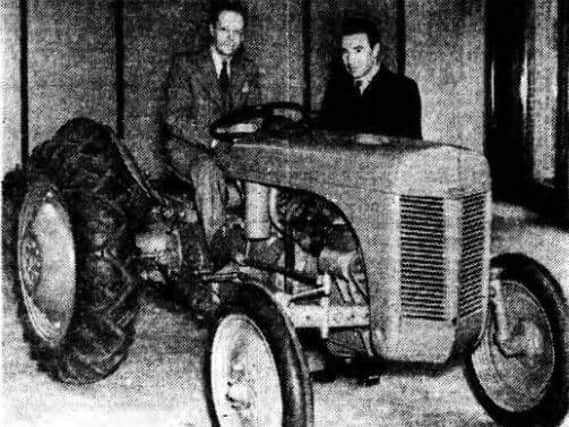BYGONE DAYS: Local production of new tractor to begin in Ulster, says Ferguson


No new factory was to be established as the work was to be done under contract by existing Ulster firms.
Local production was expected to start early next year.
Mr Ferguson was in Ulster connection with the arrival here of the first “Ferguson” tractor - the new model of the former “Ford-Ferguson” which had been made by the Standard Motors, Coventry.
Advertisement
Advertisement
The new tractor incorporated several improvements, the principal one being a new device for bettering the transport power of the tractor.
The News Letter’s correspondent noted: “This device throws the weight of the trailer load forward, and divides its weight equally between the four wheels of the tractor and the two of the trailer, so that the danger of upsets on hilly ground is avoided.”
Representatives of the Ulster Farmers’ Union, who met Mr Ferguson, were anxious concerning the possibilities of increased allocations of tractors to Ulster farmers. Questioned on this subject, Mr Ferguson said the present quota of Ferguson tractors for Ulster was ten per week, all being allocated under Ministry of Agriculture permits.
He assured his questioners that there would be a big speed-up of deliveries in the near future.
Advertisement
Advertisement
Later in the day Mr Ferguson met Dr Scott Robertson, Permanent Secretary to the Ministry of Agriculture, and discussed ideas for machinery for the better treatment of Ulster grassland.
Mr Ferguson said he hoped to be producing 200 tractors a day early next year, 500 a day in the following year and 1,000 day thereafter.
“The demand for tractors and equipment is overwhelming,” he said, “both for home use and for export, the French government alone wanting half a million tractors and 2.5 million implements.”
Hay and straw permitted to be imported from Norway
It was reported by the News Letter this week in 1950 that accordance with the Minister of Agriculture’s announcement at Stormont the previous week restrictions on the importation of hay and straw into Northern Ireland from Norway and Scotland to help deal with the growing winter fodder crisis arising from the unfavourable harvest had been eased.
Advertisement
Advertisement
The restriction had been in place to prevent the introduction of foot-and-mouth disease.
In the case of Norway the hay or straw had to be brought from the port of loading in Norway direct to Belfast and the vessel in which the hay straw was to be carried had to be cleansed and disinfected.
With regards to Scotland, only hay or straw grown in the counties of Dumbarton, Stirling, Clackmannan, Fife or Argyle, or any county north of these was permitted.
Sixmilecross farmers resolution
At a meeting of the Beragh and Sixmilecross branch of the Ulster Farmers’ Union held this week in 1938 a resolution calling on the government to “reduce the land annuities” was adopted.
Advertisement
Advertisement
The Northern Ireland government were also requested to enter into negotiations with the British government with a view to securing financial assistance for the farmers.
The meeting was addressed Mr G P Moody, organiser of the Ulster Farmers’ Union, and Mr W Rankin, organiser of the Young Farmers’ Club.